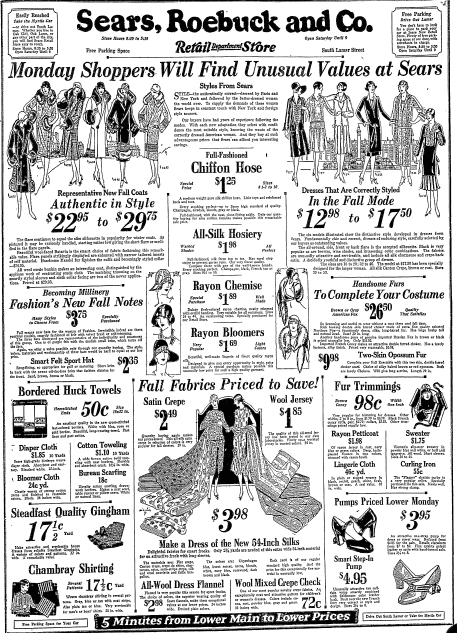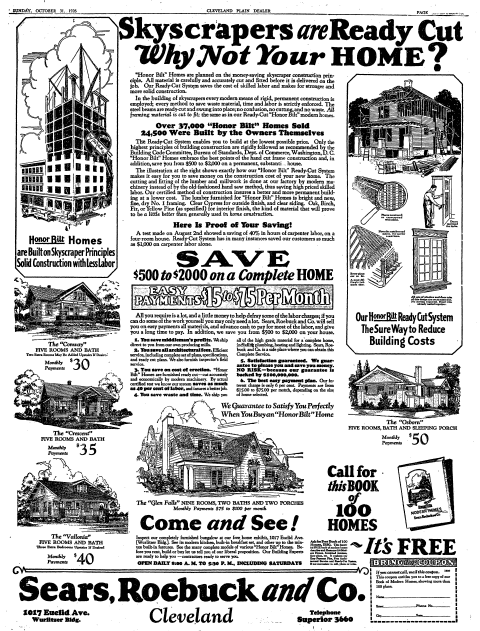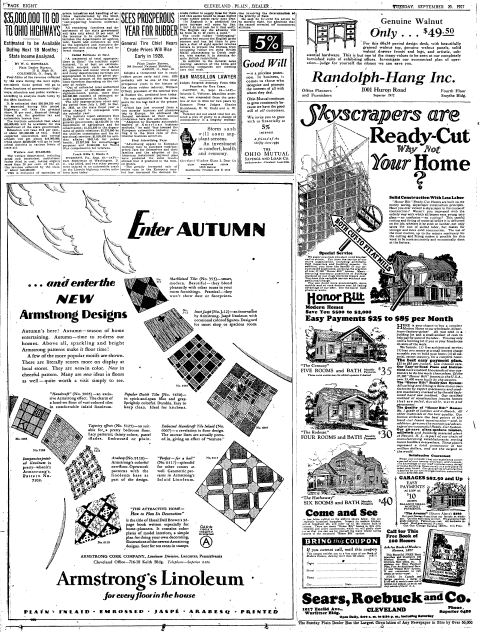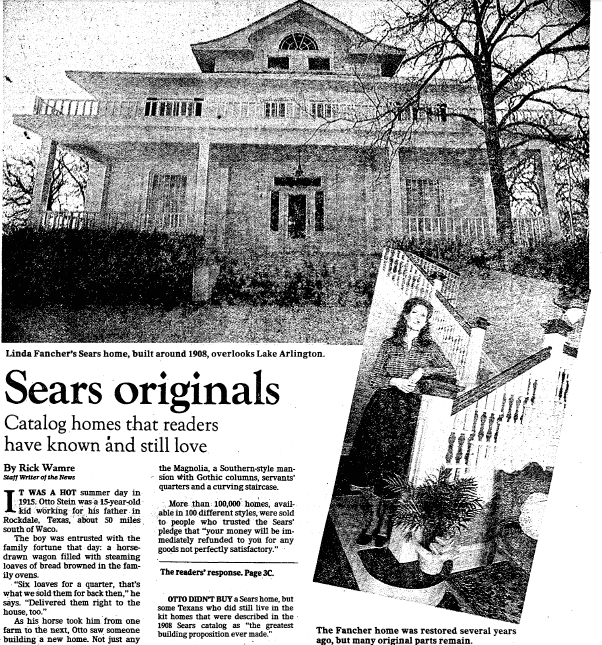Introduction: In this article, Gena Philibert-Ortega searches old newspapers to learn about a building proposition our ancestors knew well: prefabricated home kits sold by Sears, Roebuck and Co. Gena is a genealogist and author of the book “From the Family Kitchen.”
How did you buy your last home? Was it an older home that you purchased from a family who had spent years making it their own? Did you buy it brand new, built to your specifications? Maybe because of the economic downturn in the last few years you picked up a foreclosure.
While these are the ways we purchase homes now, there was a time when you could order your home as a kit from Sears! Yes, that will surprise many people who, when they think of an old Sears, Roebuck and Co. ad, have something like this 1925 full-page newspaper advertisement in mind.

Sears, the retailer of clothing, household items, and Craftsman tools—selling home kits? Yes, and they weren’t the only retailer who offered build-your-own homes to consumers. While today we often associate Sears with the catalog which began in the 1890s, in the past your family may have bought a lot more than tools, furniture, and clothes at Sears. They may have bought a new prefabricated home delivered by train!
In a 1932 publication, Sears boasted that they were the “biggest home building organization on earth.”* According to the Sears Archives, between “1908-1940 Sears, Roebuck, and Co., sold about 70,000-75,000 homes through their mail-order Modern Homes program.” Customers could also purchase garages, farm buildings and—for those purchasing small cottages—an outhouse. The Modern Home program catalog offered consumers a range of homes from the palatial to the very simple. These Sears homes were like the Ford of their times, mass produced and shipped with everything, or almost everything, the would-be home builder needed. Because of the way the Sears houses were produced, the building and construction materials were less expensive resulting in a more inexpensive home for the buyer.
In this full-page 1926 newspaper advertisement, we not only learn more about the Sears Homes and what is offered, but we are provided a glimpse into how the homeowner can put together their home kit and reduce the costs.

Innovations, such as numbering the materials to correspond with the plans, helped simplify the building process. Homes are touted as being built on the “skyscraper principle.” The Sears Archives website writes that “balloon style” framing, drywall and asphalt shingles allowed for these homes to be built relatively easier and quicker. What’s interesting is that the addition of drywall and asphalt shingles also had the added bonus of being fire resistant.

A similar historical newspaper advertisement from 1927 explains to readers that they are furnished with “free architectural service” and everything one would need “except masonry, for a complete home.” Not only that but Sears also offered, until 1933 when the program was discontinued, to lend money with a “small interest charge” so that you could afford your new Sears home. One promotional piece boasted that you could own a home for low monthly prices, just like rent.**
In 1982 this Texas newspaper “asked readers to tell us about Sears homes in Texas,” made from home kits that were described in the Sears 1908 catalog as “the greatest building proposition ever made.”

More than 30 readers responded, with stories about how much they loved their Sears homes. One satisfied Sears homeowner, Edith Sides of Dallas, lived in a home that was built in 1911 and sold to her stepfather in 1917. The family has owned the Sears kit house ever since. Edith, 74, told the newspaper:
You know how many times I’ve watched “Gone with the Wind”? Six times. And I always remember what Scarlett’s father told her: Keep the land. I have. And you know what? I think my house compares favorably with Tara.
Did someone on your family tree own a Sears kit home? Check historical newspapers (for the year that home was available) to find advertisements highlighting your ancestor’s style of home. You can also look for the exact home specifications from the Sears Archives website. Several books are available that are reprints of early Sears home catalogs and histories. Check out Google Books for titles and previews. You might also be interested in the book, The Houses That Sears Built: Everything You Ever Wanted to Know about Sears Catalog Homes, by Rosemary Thornton.
Have questions about a Sears home? Sears Homes Enthusiasts are available to answer questions about these homes. You can find a list of them and their interests on the Sears Archives website.
Explore over 330 years of newspapers and historical records in GenealogyBank. Discover your family story! Start a 7-Day Free Trial
______________
*Sears House Designs of the Thirties. Sears, Roebuck, and Co. Dover Publications 2003. pg. 2.
**Sears House Designs of the Thirties. Sears, Roebuck, and Co. Dover Publications 2003. pg. 5.

Hi, Gena! I research the histories of Sears houses all the time for my website and I think old newspapers are an invaluable resource. You can also search the house address in the real estate transactions. Sometimes you’ll see that “Sears Roebuck” was the holder of the mortgage–in that case, you’ve found yourself a Sears house.
BTW the “Sears” house pictured in the Dallas newspaper… it’s not one.
Thanks for the article!
Lara,
Thanks for your tips! I appreciate that. I bet you’ve found some interesting history in your research.
Thank you for taking the time to read and comment on the article. I appreciate it.
Gena
Menard’s (at least in the Chicago area) does this today. You can special order about 4 different floor plans from them, and most of the required materials (there’s a list of what you have to provide) show up by semi. Always makes me think of the Sears homes when I see those Menards ads.
Hi Cathy!
Thanks for providing a modern day example. Even at the time Sears was doing this there were other companies who sold these types of homes. Today, sometimes homes are misidentified as Sears homes when in reality they were purchased through a competitor.
Thanks for your comment.
Gena
Hi Gena,
I’ve been researching Sears homes for several years now. Rosemary Thornton is a good friend of mine! I have all but one of the Sears Modern Homes catalogs in my collection. This house was never offered by Sears and in fact, in 1908 they offered nothing even close to this. I have uploaded a 1908 Sears Modern Homes catalog in full on flickr if you want to look through it.
BTW, there’s a group on facebook called Sears Homes that you can join. It is the group of Rosemary Thornton the author mentioned above!
And, unfortunately it’s not from Aladdin or Gordon Van Tine who were the only other major companies selling kit homes in 1908. There is a possibility it was built from a pattern ordered from a catalog or a popular trade journal. I hope you find it one day!
Thanks for your comments Rachel. I appreciate the information. I’ll be checking out your flickr images.
–Gena
What should I do if I am fairly certain that we bought a Sears kit home that is on a 5 acre lot that we recently purchased?
Joy,
You can check out the Sears Archive website to connect with others who are Sears homes enthusiasts. You can also find the promotional materials for each house which would provide you more information about your home. http://searsarchives.com/